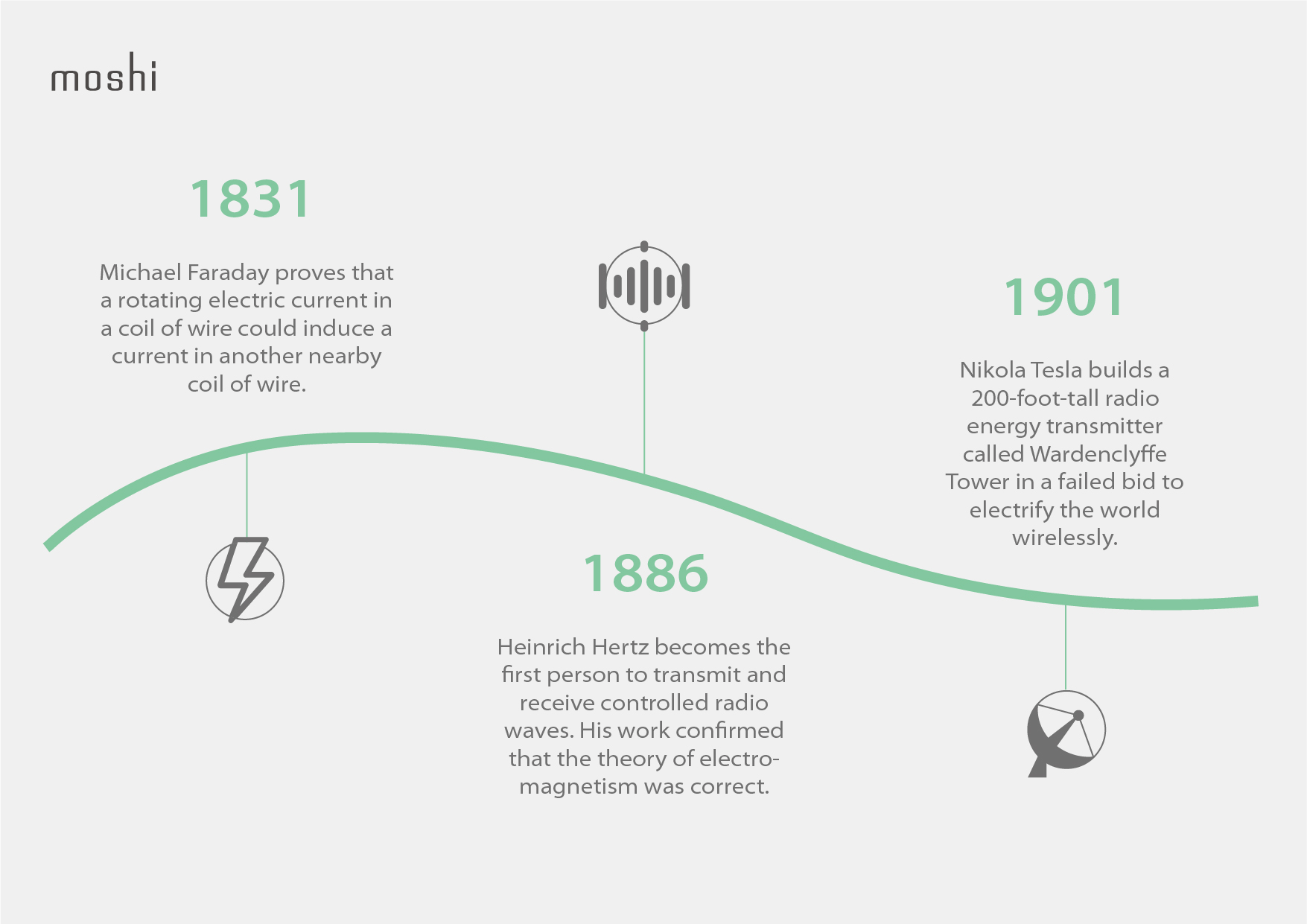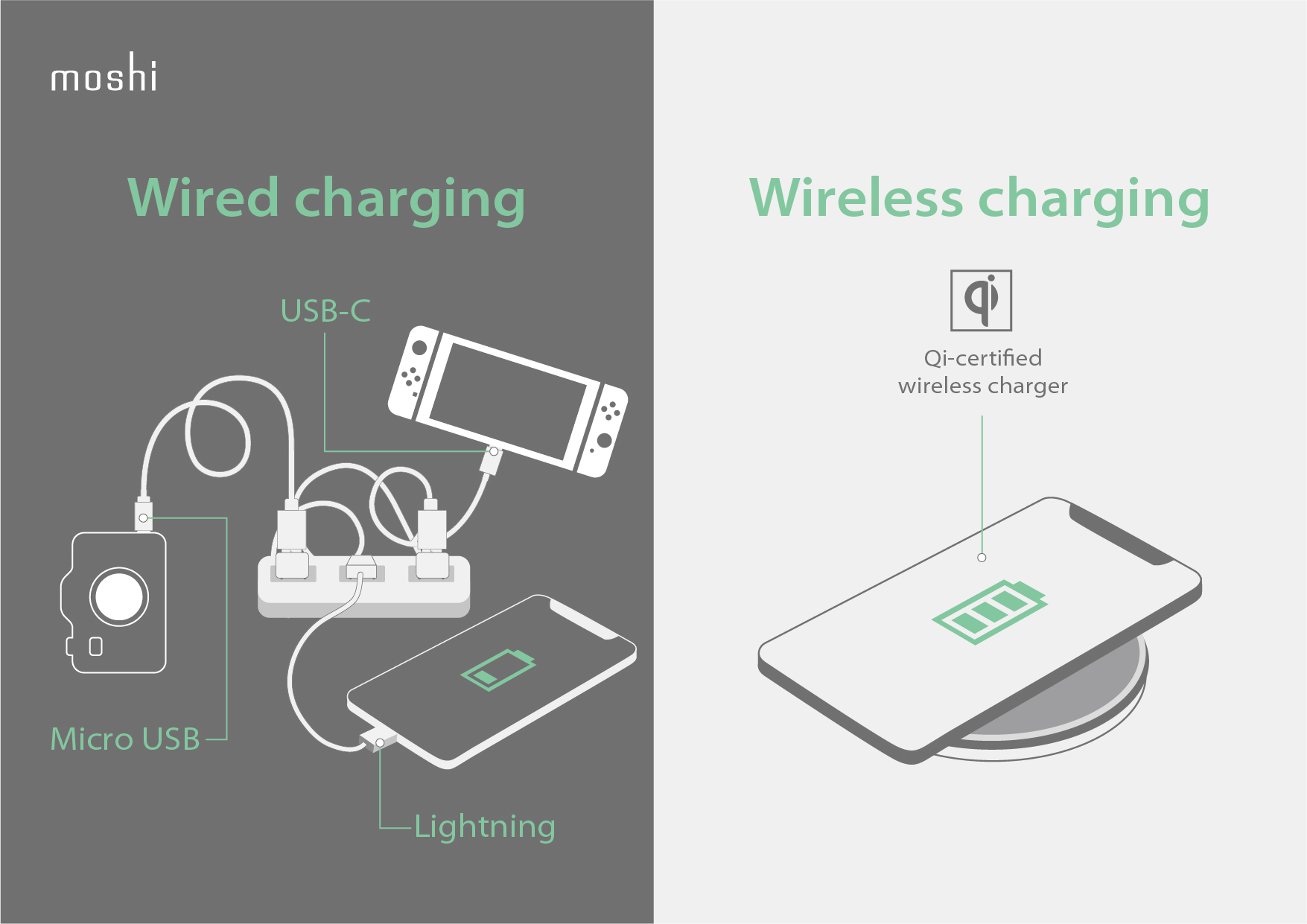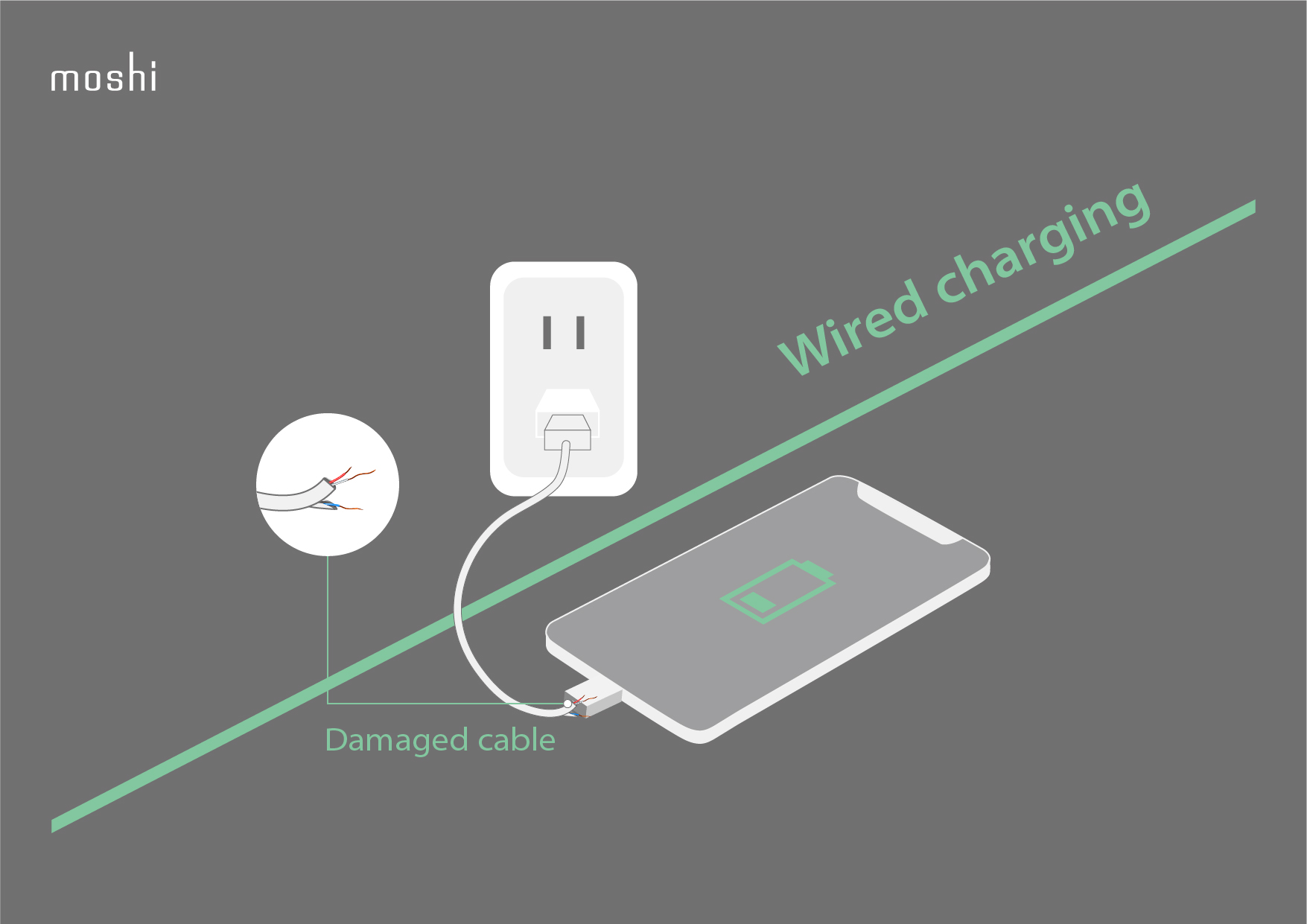The Ultimate Guide to Wireless Charging
When wireless charging first hit mainstream devices around 2012, the media hype was huge. Tech writers promised readers they'd be able to throw out their collections of mismatched cables and adapters. To charge, you'd plop your phone on a table, bowl, or desk as you walked by—like magic.
Although there were still a few kinks to work out, wireless charging technology continued to advance. Today, it's safe to say that convenient and efficient wireless charging has arrived—and it just keeps getting better.
Was the initial hype surrounding the technology warranted? As more consumers discover the ease and simplicity of wireless charging, it looks like the answer is yes.
History of wireless inductive charging
The desire to go wireless isn't new. People have been trying to transmit power without wires as long as there have been practical applications for it.
Here's a brief timeline of the early years of wireless power transmission:

Despite this progress, significant barriers to efficient wireless transmission remained. With few practical applications to be found, the technology crawled forward over the next 100 years. But the mobile device boom at the beginning of the 21st Century created a big incentive for researchers to revisit wireless charging.
This massive new market for wireless charging spurred progress, but it also created conflict—and headaches for consumers. For several years starting in 2006, different wireless charging standards competed for dominance.
These included the Powermat standard (adopted by heavy hitters like General Motors, Starbucks, and Delta Airlines) and the Wireless Power Consortium's (WPC's) Qi standard (first backed by tech powerhouses like Samsung, Google, and Verizon).
During this period, wireless charging fell short of its promise to make mobile devices easier to use. Most smartphone brands supported only one wireless charging standard (with the notable exception of Samsung). This often left consumers unable to use wireless charging stations without an adaptive case for their device.
By 2018, the Qi standard had won out. Apple's iPhone 8 family was the first generation of Apple phones to support wireless charging, and the rest is history. Powermat's entry into the WPC and the widespread adoption of the Qi standard ended the wireless charging wars.
Finally, wireless charging became practical thanks to everyone following a single standard.
Today, almost every wireless charger uses Qi, and most mobile devices support Qi wireless charging. The glass backs found on many new smartphones reflect the enormous demand for wireless charging (metal backs interfere with charging efficiency).
In the future, we can expect wireless charging to move well beyond smartphones. Before long, laptops, kitchen appliances, and even electric cars may all be capable of wireless charging.
"Today, almost every wireless charger uses Qi, and most mobile devices support Qi wireless charging."
How does wireless charging work?
Wireless charging works off the principle of electromagnetic induction. It's the same principle behind those induction stoves that have been around for years.
Both the charger and the receiving device contain wireless charging coils. The transmitting coil is located in the charging pad. The receiving coil is situated at the back of the phone and connected to the battery.
The transmitting coil converts electricity and emits an alternating electromagnetic field. When the receiving coil is within this field, it turns the energy into an electric current that is sent to the battery.

The evolution of Qi
The Qi standard (pronounced "chee") is named after the Chinese concept of the flow of vital energy through every living thing.
Set by the WPC, the Qi standard defines various power specifications that correspond to how much energy flows between charger and device. Qi also includes a data transfer spec which lets the device request the optimal amount of power from the wireless charger.

The Baseline Power Profile (BPP) specification supports up to 5 W of power output. The Extended Power Profile (EPP) specification supports up to 15 W. Both BPP and EPP are used to charge mobile devices, but EPP is more advanced thanks to its fast-charging support. For a more in-depth explainer, check out our blog article.
The Qi standard also includes a Medium power spec that currently delivers 30-65 W (it's expected to eventually support up to 200 W). This spec is used for larger devices like kitchen appliances, robotic vacuum cleaners, power tools, and drones.

Fast-charging with Qi
The difference between BPP and EPP may seem technical, but it has a significant impact on your wireless charging experience. All wireless charging products for mobile devices use either BPP (5 W maximum) or EPP (15 W maximum), and you might think that since EPP chargers can output more power, buying an EPP charger will automatically lead to faster charging. But that's not necessarily the case.
Your mobile device's ability to receive power is the limiting factor when it comes to charging speed. Your device must be able to receive 7 W of power to be capable of fast wireless charging, no matter what kind of charger you use.
Your phone's ability to receive power output is predetermined by the manufacturer. Here are the specs for a few major brands:
- Apple: 7.5 W
- Sony: 11 W
- LG: 10 W
- Google: 12 W*
- Samsung: 9 W**
*12 W charging for Pixel 5 devices
** Samsung requires that wireless chargers pass the additional Samsung Proprietary Power Delivery Extension (PPDE) certification in order to deliver power above 5 W. EPP chargers not certified under this extension will only charge at BPP wattage when used with Samsung phones. Read more about Samsung phones which support Qi wireless charging.
"Your device must be able to receive 7 W of power to be capable of fast wireless charging, no matter what kind of charger you use."
Even if your phone and charger both support fast wireless charging, choosing the wrong accessories can still slow you down. Both your cable and wall adapter must be able to receive enough power to be capable of fast charging. For example, if you own a 10 W charging pad plugged into a 5 W wall charger, your device will only charge at 5 W so you won't get the benefits of fast charging.
Make sure your device, cable, and wall charger all support enough power to enable fast wireless charging. Here's an example of a setup that will work:
- USB-C Wall Charger (10 W)
- USB-C to USB-C cable
- Charging pad (10 W)
What are the key advantages of wireless charging?
Less clutter
The main benefit of wireless charging is right there in the name—wireless. Wireless charging cuts down on clutter from charging cables. The only cable you'll need is the charging pad's power cable.

Easier charging
Wireless charging also eliminates the need to plug a cable into your phone. Ever plugged your phone in and discovered hours later that the cable connection wasn't secure—and your phone is still dead? Wireless charging eliminates that problem. Just place your phone on your charging pad, and it'll start charging right away.
Longer device life
No repeated cable plugging and pulling means less wear and tear on your phone's charging port. Since the charging port is a common point of failure for mobile devices, your phone may even last longer.
No cable compatibility issues
No charging cables also means you can say goodbye to that timeless problem among tech enthusiasts—mismatched connectors. No need to worry about not having a Lightning, USB-C, or Micro USB cable on hand anymore. All Qi devices work on all Qi charging pads.
Less e-waste
The benefits of reducing e-clutter go far beyond your personal tidiness. The current lack of a common wired charging standard leads to an enormous amount of unnecessary e-waste. The widespread adoption of wireless charging could help solve this problem.
Currently, most Android devices use USB-C ports, while Apple devices use the Lightning connector exclusively. That means that to switch from Android to Apple or vice versa, you need to get new charging cables (and maybe new adapters). Unfortunately, your old cables and adapters are very likely to end up in a landfill.
Charging cables may be small, but the e-waste problem isn't.

In January 2020, the European Parliament voted for new regulations to establish a universal charging standard for phone manufacturers in the European Union. The EU claims that agreeing on a shared charger standard will put an end to charger clutter and 50 million metric tonnes of e-waste annually (16.6 kg per inhabitant).
Wireless charging is ahead of the game when it comes to reducing e-waste. Qi wireless charging has already achieved a universal charging standard. Apple, Android, and Google all support the Qi standard, making it the most reliable charging standard today.
Safer charging products
As more users adopt wireless charging, additional benefits of standardized chargers will become clear. The quality of charging products on the market should go up, with fewer counterfeit chargers being sold. That will guarantee a higher level of safety for users worldwide.
6 myths about wireless charging
Despite its advancements, there are still many people with concerns about wireless charging. Most of these worries are holdovers from the old days of wireless charging when the standards weren't quite as refined.
Here are some of the most common myths and misconceptions busted.
1. Wireless charging is slow
This misconception may date back to wireless charging's 5 W days. It definitely was slow back then. But today's fast wireless charging pads can provide 10 or even 15 W of power, which is as fast or even faster than wired charging.
2. Wireless charging is inefficient
The conversion from electric current to electromagnetic field and back doesn't cause significant efficiency losses. You can recover as much as 80% of the input wattage when charging wirelessly, but make sure your wireless charger features an efficient coil design. Cheap uncertified wireless chargers tend to use inferior materials and components which can affect efficiency.
3. Wireless charging is dangerous
Some people think the energy transmitted wirelessly could be hazardous to your body. However, magnetic induction only works across very short distances. At a distance of only 4 cm, you're totally safe from any potential effects of the radiation, and charging pads do not emit electromagnetic radiation constantly. Qi-certified chargers won't produce a magnetic charging field unless a phone is on the pad.

4. Wireless charging can overheat your phone's battery
All charging (both wired and wireless) generates some heat, but solid electrical engineering can keep heat levels low enough to prevent battery damage. That's why it's essential to buy wireless chargers from a reputable brand. Learn why Moshi’s Q-coil technology keeps your device cool and was rated “the fastest wireless charger” in the world.

5. Frequent wireless charging degrades your phone's battery life
Charging in general doesn’t have an impact on battery life, and wireless charging may actually be safer than certain fast-charging cables. Qi wireless chargers use a lower current compared to wired charging, which creates a more stable charging scenario. Wireless chargers also make it easy to top off your battery throughout the day. By setting your phone on a nearby charging pad when not in use, you can prevent the battery from dropping below 50%, which may increase the overall lifespan of your battery.


6. Overnight wireless charging can damage your phone
For many people, overnight is the most convenient time to charge. However, some worry that charging while you sleep can lead to overcharging and potential battery damage. Luckily, this isn't something we need to be concerned about. Smartphone batteries have a charge control system that disconnects the battery from the charger as soon as the battery is 100% charged. No matter how long the phone sits on the charger, it stays at the cut-off of the charging current with no risk of overcharging. That applies to both wireless and wired charging.
The future of wireless charging
Wireless charging has a bold, bright future ahead of it. More and more manufacturers are including Qi support in their phones, and peripheral manufacturers are adding Qi charging to more devices.
Wirelessly charging your smartphone will probably get even easier as charging technology advances. Manufacturers like Google and Samsung now support reverse wireless charging on some models, which allows phones to wirelessly charge other phones and smaller devices such as earbuds.
The charging pad itself could be getting a makeover. Some devices like monitors and mouse pads now include integrated wireless charging. New accessories like Moshi’s SnapTo Series feature wireless charging built directly into the mount. Even furniture makers are getting in on the action by creating Qi-enabled tables and desks. That's precisely the kind of innovation that got people so excited about wireless charging when it first hit the scene.
Wondering when larger devices will cut the cord? It's already happening.
In June 2017, Dell launched the world's first laptop that can charge wirelessly using magnetic resonance charging technology. You can expect to see more manufacturers rolling out wireless charging-enabled laptops over the next few years.
Tired of trying to find counter space near an outlet for your Instant Pot, rice cooker, or food processor? Soon you won't need to. The WPC's upcoming Ki Cordless Kitchen standard will deliver up to 2200 W to kitchen appliances wirelessly.

When it comes to wireless charging, the future has finally arrived. There's never been a better time to adopt this promising technology.
Learn more: Q-coil Technology
Moshi’s Q-coil wireless charging module features a multilayer heat sink design for enhanced passive cooling. Unlike cheap wireless chargers made with entry-level components, Q-coil chargers stay cool even while fast-charging.

These are some of the high-quality components and materials that make this possible:
- Our charging coil module uses high-purity copper wire and a high quality ferrite sheet to improve charging efficiency and reduce temperature.
- Low-resistance DC/DC power converters improve conversion efficiency and regulate the circuit board's temperature.
- A special multilayer heat sink dissipates the charger's thermal energy downwards, reducing heat transfer between the charger and the phone.
- Built-in over-voltage, over-current, and over-temperature protection circuits make the charging process safer.
- Qi certification ensures charging compatibility, reliability and safety.
Learn more about the Qi wireless charging specification with our handy guide to Qi EPP, or check out our Q Collection Qi-certified wireless chargers.
Sample Block Quote
Praesent vestibulum congue tellus at fringilla. Curabitur vitae semper sem, eu convallis est. Cras felis nunc commodo loremous convallis vitae interdum non nisl. Maecenas ac est sit amet augue pharetra convallis nec danos.
Sample Paragraph Text
Praesent vestibulum congue tellus at fringilla. Curabitur vitae semper sem, eu convallis est. Cras felis nunc commodo eu convallis vitae interdum non nisl. Maecenas ac est sit amet augue pharetra convallis nec danos dui.
Cras suscipit quam et turpis eleifend vitae malesuada magna congue. Damus id ullamcorper neque. Sed vitae mi a mi pretium aliquet ac sed elitos. Pellentesque nulla eros accumsan quis justo at tincidunt lobortis denimes loremous. Suspendisse vestibulum lectus in lectus volutpat, ut dapibus purus pulvinar. Vestibulum sit amet auctor ipsum.










Watches World
In the realm of high-end watches, discovering a reliable source is crucial, and WatchesWorld stands out as a pillar of trust and knowledge. Presenting an wide collection of prestigious timepieces, WatchesWorld has accumulated praise from content customers worldwide. Let’s dive into what our customers are saying about their experiences.
Customer Testimonials:
O.M.’s Review on O.M.:
“Excellent communication and aftercare throughout the process. The watch was flawlessly packed and in perfect condition. I would certainly work with this group again for a watch purchase.”
Richard Houtman’s Review on Benny:
“I dealt with Benny, who was exceptionally helpful and courteous at all times, preserving me regularly informed of the procedure. Moving forward, even though I ended up acquiring the watch locally, I would still definitely recommend Benny and the company.”
Customer’s Efficient Service Experience:
“A very good and swift service. Kept me up to date on the order progress.”
Featured Timepieces:
Richard Mille RM30-01 Automatic Winding with Declutchable Rotor:
Price: €285,000
Year: 2023
Reference: RM30-01 TI
Patek Philippe Complications World Time 38.5mm:
Price: €39,900
Year: 2019
Reference: 5230R-001
Rolex Oyster Perpetual Day-Date 36mm:
Price: €76,900
Year: 2024
Reference: 128238-0071
Best Sellers:
Bulgari Serpenti Tubogas 35mm:
Price: On Request
Reference: 101816 SP35C6SDS.1T
Bulgari Serpenti Tubogas 35mm (2024):
Price: €12,700
Reference: 102237 SP35C6SPGD.1T
Cartier Panthere Medium Model:
Price: €8,390
Year: 2023
Reference: W2PN0007
Our Experts Selection:
Cartier Panthere Small Model:
Price: €11,500
Year: 2024
Reference: W3PN0006
Omega Speedmaster Moonwatch 44.25 mm:
Price: €9,190
Year: 2024
Reference: 304.30.44.52.01.001
Rolex Oyster Perpetual Cosmograph Daytona 40mm:
Price: €28,500
Year: 2023
Reference: 116500LN-0002
Rolex Oyster Perpetual 36mm:
Price: €13,600
Year: 2023
Reference: 126000-0006
Why WatchesWorld:
WatchesWorld is not just an online platform; it’s a promise to personalized service in the world of luxury watches. Our staff of watch experts prioritizes trust, ensuring that every client makes an knowledgeable decision.
Our Commitment:
Expertise: Our team brings exceptional knowledge and perspective into the realm of luxury timepieces.
Trust: Trust is the foundation of our service, and we prioritize transparency in every transaction.
Satisfaction: Customer satisfaction is our paramount goal, and we go the extra mile to ensure it.
When you choose WatchesWorld, you’re not just buying a watch; you’re committing in a effortless and reliable experience. Explore our collection, and let us assist you in finding the perfect timepiece that mirrors your style and sophistication. At WatchesWorld, your satisfaction is our time-tested commitment
Watches World
In the world of luxury watches, locating a trustworthy source is crucial, and WatchesWorld stands out as a beacon of trust and knowledge. Providing an extensive collection of renowned timepieces, WatchesWorld has accumulated acclaim from satisfied customers worldwide. Let’s dive into what our customers are saying about their encounters.
Customer Testimonials:
O.M.’s Review on O.M.:
“Excellent communication and follow-up throughout the process. The watch was perfectly packed and in perfect condition. I would certainly work with this group again for a watch purchase.”
Richard Houtman’s Review on Benny:
“I dealt with Benny, who was highly supportive and courteous at all times, maintaining me regularly informed of the process. Moving forward, even though I ended up acquiring the watch locally, I would still definitely recommend Benny and the company.”
Customer’s Efficient Service Experience:
“A very good and efficient service. Kept me up to date on the order progress.”
Featured Timepieces:
Richard Mille RM30-01 Automatic Winding with Declutchable Rotor:
Price: €285,000
Year: 2023
Reference: RM30-01 TI
Patek Philippe Complications World Time 38.5mm:
Price: €39,900
Year: 2019
Reference: 5230R-001
Rolex Oyster Perpetual Day-Date 36mm:
Price: €76,900
Year: 2024
Reference: 128238-0071
Best Sellers:
Bulgari Serpenti Tubogas 35mm:
Price: On Request
Reference: 101816 SP35C6SDS.1T
Bulgari Serpenti Tubogas 35mm (2024):
Price: €12,700
Reference: 102237 SP35C6SPGD.1T
Cartier Panthere Medium Model:
Price: €8,390
Year: 2023
Reference: W2PN0007
Our Experts Selection:
Cartier Panthere Small Model:
Price: €11,500
Year: 2024
Reference: W3PN0006
Omega Speedmaster Moonwatch 44.25 mm:
Price: €9,190
Year: 2024
Reference: 304.30.44.52.01.001
Rolex Oyster Perpetual Cosmograph Daytona 40mm:
Price: €28,500
Year: 2023
Reference: 116500LN-0002
Rolex Oyster Perpetual 36mm:
Price: €13,600
Year: 2023
Reference: 126000-0006
Why WatchesWorld:
WatchesWorld is not just an online platform; it’s a dedication to individualized service in the world of luxury watches. Our team of watch experts prioritizes trust, ensuring that every customer makes an informed decision.
Our Commitment:
Expertise: Our team brings exceptional understanding and perspective into the world of high-end timepieces.
Trust: Confidence is the foundation of our service, and we prioritize openness in every transaction.
Satisfaction: Customer satisfaction is our ultimate goal, and we go the extra mile to ensure it.
When you choose WatchesWorld, you’re not just purchasing a watch; you’re investing in a seamless and reliable experience. Explore our collection, and let us assist you in discovering the perfect timepiece that reflects your taste and sophistication. At WatchesWorld, your satisfaction is our proven commitment
Изготовление и использование дубликатов банковских карт является противозаконной практикой, представляющей существенную угрозу для безопасности финансовых систем и личных средств граждан. В данной статье мы рассмотрим потенциальные опасности и последствия покупки клонов карт, а также как общество и полиция борются с подобными преступлениями.
“Клоны” карт — это пиратские реплики банковских карт, которые используются для неправомерных транзакций. Основной метод создания копий — это похищение данных с оригинальной карты и последующее настройка этих данных на другую карту. Злоумышленники, предлагающие услуги по продаже реплик карт, обычно действуют в теневой сфере интернета, где трудно выявить и пресечь их деятельность.
Покупка реплик карт представляет собой значительное преступление, которое может повлечь за собой тяжкие наказания. Покупатель также рискует стать пособником мошенничества, что может привести к уголовному преследованию. Основные преступные действия в этой сфере включают в себя хищение личной информации, подделку документов и, конечно же, финансовые преступления.
Банки и полиция активно борются с незаконными действиями, связанными с копированием карт. Банки внедряют современные технологии для определения подозрительных транзакций, а также предлагают услуги по обеспечению защиты для своих клиентов. Полиция ведут следственные мероприятия и задерживают тех, кто замешан в изготовлении и продаже копий карт.
Для обеспечения безопасности важно соблюдать бережность при использовании банковских карт. Необходимо постоянно проверять выписки, избегать сомнительных сделок и следить за своей личной информацией. Образование и информированность об угрозах также являются важными средствами в борьбе с финансовыми преступлениями.
В заключение, использование дубликатов банковских карт — это противозаконное и неприемлемое деяние, которое может привести к серьезным последствиям для тех, кто вовлечен в такую практику. Соблюдение мер обеспечения безопасности, осведомленность о возможных опасностях и сотрудничество с силовыми структурами играют важную роль в предотвращении и пресечении аналогичных преступлений
娛樂城推薦
Теневые рынки и их незаконные деятельности представляют значительную угрозу безопасности общества и являются объектом внимания правоохранительных органов по всему миру. В данной статье мы обсудим так называемые неофициальные рынки, где возможно покупать нелегальные паспорта, и какие угрозы это несет для граждан и государства.
Теневые рынки представляют собой скрытые интернет-площадки, на которых торгуется разнообразной нелегальной продукцией и услугами. Среди этих услуг встречается и продажа поддельных удостоверений, таких как личные документы. Эти рынки оперируют в неофициальной сфере интернета, используя шифрование и неизвестные платежные системы, чтобы оставаться незаметными для правоохранительных органов.
Покупка поддельного паспорта на теневых рынках представляет важную угрозу национальной безопасности. хищение личных данных, подделывание документов и поддельные идентификационные материалы могут быть использованы для совершения экстремистских актов, обманного характера и прочих преступлений.
Правоохранительные органы в различных странах активно борются с подпольными рынками, проводя операции по выявлению и аресту тех, кто замешан в незаконных сделках. Однако, по мере того как технологии становятся более комплексными, эти рынки могут приспосабливаться и находить новые методы обхода законов.
Для предотвращения угроз от опасностей, связанных с подпольными рынками, важно проявлять осторожность при обработке своих личной информации. Это включает в себя избегать атак методом фишинга, не распространять информацией о себе в недоверенных источниках и регулярно контролировать свои финансовые отчеты.
Кроме того, общество должно быть знающим о рисках и последствиях покупки нелегальных документов. Это позволит создать более осознанное и ответственное отношение к вопросам безопасности и поможет в борьбе с скрытыми рынками. Поддержка законодательства, направленных на ужесточение наказаний за создание и продажу нелегальных документов, также представляет важное направление в борьбе с этими преступлениями